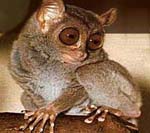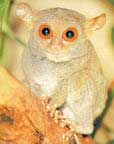Contrary to popular belief, the Philippine Tarsier is not the "world's smallest monkey". Known locally as the maonmag or mago, it is actually the world's smallest primate. Primates are the genetic family which includes both monkeys and humans. The tarsier belongs to a primate species all its own which is about 36 million years old. It stands about 5 inches tall - small enough to fit snugly in the human hand. Its tail is about 9 inches long and partly covered with fur, arching over its back when it hops on the ground. To communicate with each other, tarsiers generally make chirping sounds similar to those made by locusts. They also occasionally make loud shrill calls and soft bird-like noises.
HUNTING BY MOONLIGHT
 As a nocturnal hunter, the tarsier is well-equipped for stalking insects, lizards, and small amphibians at night. Its main hunting tools are its huge eyes, each of which is bigger than its entire brain. These eyes enable the tarsier to see clearly in the dark. Though its eyeballs do not move in their sockets, a tarsier can turn its head 180 degrees in both directions. Flexible ears allow it to locate prey and at the same time avoid predators. A tarsier's powerful thighs which somewhat resemble those of a frog help it move around the forest at top speed. Elongated ankle or tarsal bones provide the tarsier its name. Using these specially-designed legs to a distance of almost ten feet in the blink of an eye. Pointed nails and fingerpads help it cling to trees.
As a nocturnal hunter, the tarsier is well-equipped for stalking insects, lizards, and small amphibians at night. Its main hunting tools are its huge eyes, each of which is bigger than its entire brain. These eyes enable the tarsier to see clearly in the dark. Though its eyeballs do not move in their sockets, a tarsier can turn its head 180 degrees in both directions. Flexible ears allow it to locate prey and at the same time avoid predators. A tarsier's powerful thighs which somewhat resemble those of a frog help it move around the forest at top speed. Elongated ankle or tarsal bones provide the tarsier its name. Using these specially-designed legs to a distance of almost ten feet in the blink of an eye. Pointed nails and fingerpads help it cling to trees.
BOHOL AND BEYOND
The lush primary or natural forests of Bohol are once the only known habitat of the Philippine Tarsier. With deforestation and the use of pesticides, the tarsiers was listed as an endangered species. Fortunately, it has recently been found that tarsiers thrive even in the secondary or man-made forests in Bilar and other lowland and coastal areas. These forests teem with insects and other animals that comprise the tarsier's diet. This discovery has raised the number of tarsiers and taken it off the endangered list. Tarsiers have also been confirmed in the forested areas of Samar, Leyte, and in Dinagat and Siargao Islands as well as in Mindanao. Two other species of tarsier are likewise found in Malaysia and Indonesia.
CRISIS IN CAPTIVITY
Because of their cute size and appearance, tarsiers became popular as pets. Strong demand from petshops here and abroad kept tarsier hunters in the business. However, captivity has proven to be harsh on the tarsier which is known to be an extremely nervous animal. In captivity, tarsiers tend to huddle together with tails intertwined. They are made to eat shrimps placed in cups of water instead of their natural diet of live insects and reptiles. Thus, instead of living out their usual lifespan of 13-and-a-half years, these pitiful little creatures are so traumatized by human handling that they almost certainly die immediately after capture.
 Today, the Department of Environment and Natural Resources (DENR) together with the Rajah Sikatuna National Park and the municipal governments of Bohol work hand-in-hand to protect the tarsier. Conservation efforts include the recruitment of former tarsier hunters, educating and converting them into forest rangers. While the hunting and trade of tarsiers are now prohibited by law, tourists can still catch a glimpse of these fascinating creatures in captive breeding programs operated by private groups and local governments and sanctioned by the DENR.
Today, the Department of Environment and Natural Resources (DENR) together with the Rajah Sikatuna National Park and the municipal governments of Bohol work hand-in-hand to protect the tarsier. Conservation efforts include the recruitment of former tarsier hunters, educating and converting them into forest rangers. While the hunting and trade of tarsiers are now prohibited by law, tourists can still catch a glimpse of these fascinating creatures in captive breeding programs operated by private groups and local governments and sanctioned by the DENR.